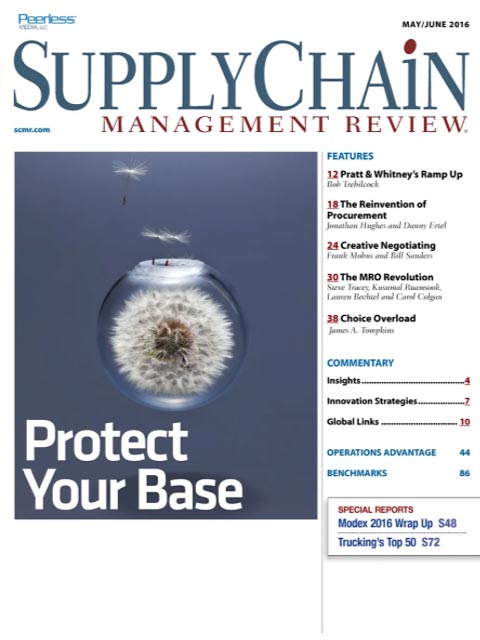Sorry, but your login has failed. Please recheck your login information and resubmit. If your subscription has expired, renew here.
May-June 2016
The procurement function is at an inflection point.” So begins “The reinvention of procurement," an article by Jonathan Hughes and Danny Ertel, partners at the Boston-based consulting firm Vantage Partners. The authors argue that while many leading companies have transformed their procurement organizations into a linchpin of their enterprise strategy, far too many others remain trapped by procurement models that are out of date in today’s fastpaced economy, where the acquisition of innovation, collaboration, services and solutions is more important than transactions based on the lowest cost per unit. Reinvention is a fitting theme for… Browse this issue archive.Need Help? Contact customer service 847-559-7581 More options
Vigilance is a must no matter where you are doing business in today’s global marketplace. Indeed, add “cyber exposure,” extreme weather conditions and widespread fraud and piracy to the mix of their concerns, and supply chain managers have a daunting checklist to address before supply chains can be regarded as efficient and secure.
When it comes to ocean cargo shipping—the backbone of global supply chains—the world appears to be more secure: According to the Allianz Global Corporate & Specialty (AGCS) fourth annual Safety and Shipping Review 2016, vessel losses declined by 3% last year. Furthermore, losses have declined by 45% since 2006, driven by an increasingly robust safety environment and self-regulation.
While the long-term downward trend in shipping losses is encouraging, there are still reasons to be concerned as weak economic and market conditions, depressed commodity prices and an excess of ships continue to pres¬sure costs and raise safety concerns. AGCS has seen an increase in the frequency of loss¬es over the past year that can be attributed to this environment to some extent.
 |
This complete article is available to subscribers
only. Click on Log In Now at the top of this article for full access. Or, Start your PLUS+ subscription for instant access. |
SC
MR
Sorry, but your login has failed. Please recheck your login information and resubmit. If your subscription has expired, renew here.
May-June 2016
The procurement function is at an inflection point.” So begins “The reinvention of procurement," an article by Jonathan Hughes and Danny Ertel, partners at the Boston-based consulting firm Vantage Partners.… Browse this issue archive. Access your online digital edition. Download a PDF file of the May-June 2016 issue.
 |
Download Article PDF |
Vigilance is a must no matter where you are doing business in today's global marketplace. Indeed, add “cyber exposure,” extreme weather conditions and widespread fraud and piracy to the mix of their concerns, and supply chain managers have a daunting checklist to address before supply chains can be regarded as efficient and secure.
When it comes to ocean cargo shipping—the backbone of global supply chains—the world appears to be more secure: According to the Allianz Global Corporate & Specialty (AGCS) fourth annual Safety and Shipping Review 2016, vessel losses declined by 3% last year. Furthermore, losses have declined by 45% since 2006, driven by an increasingly robust safety environment and self-regulation.
While the long-term downward trend in shipping losses is encouraging, there are still reasons to be concerned as weak economic and market conditions, depressed commodity prices and an excess of ships continue to pres¬sure costs and raise safety concerns. AGCS has seen an increase in the frequency of loss¬es over the past year that can be attributed to this environment to some extent.
 |
SUBSCRIBERS: Click here to download PDF of the full article. |
SC
MR

Latest Supply Chain News
- Despite American political environment, global geopolitical risks may be easing
- Joseph Esteves named CEO of SGS Maine Pointe
- Employees, employers hold divergent views on upskilling the workforce
- April manufacturing output slides after growing in March
- Q1 sees a solid finish with positive U.S.-bound import growth, notes S&P Global Market Intelligence
- More News
Latest Podcast

 Explore
Explore
Latest Supply Chain News
- Despite American political environment, global geopolitical risks may be easing
- Joseph Esteves named CEO of SGS Maine Pointe
- Employees, employers hold divergent views on upskilling the workforce
- April manufacturing output slides after growing in March
- Q1 sees a solid finish with positive U.S.-bound import growth, notes S&P Global Market Intelligence
- World Trade Centers offers a helping hand to create resilient, interconnected supply chains
- More latest news
Latest Resources

Subscribe

Supply Chain Management Review delivers the best industry content.

Editors’ Picks






